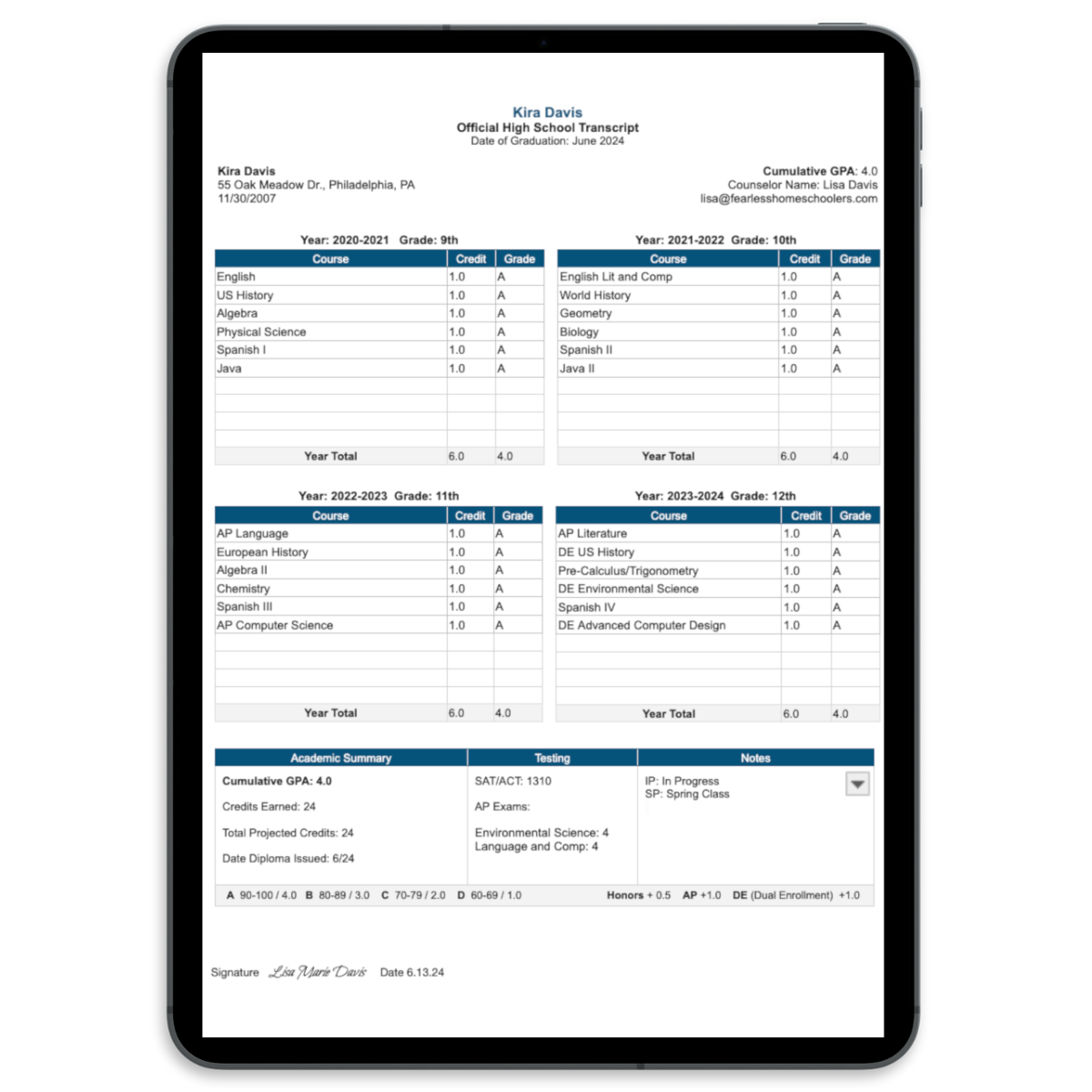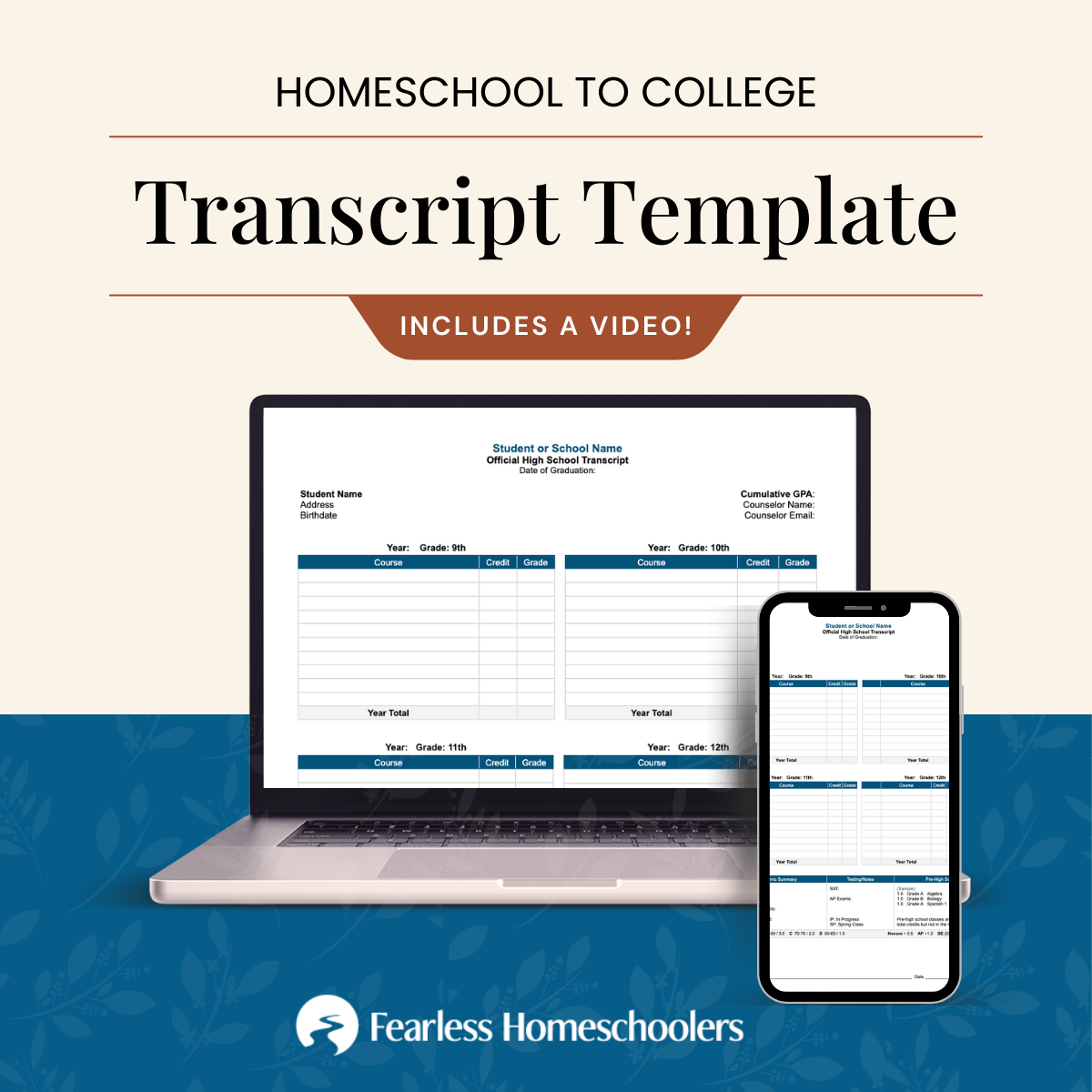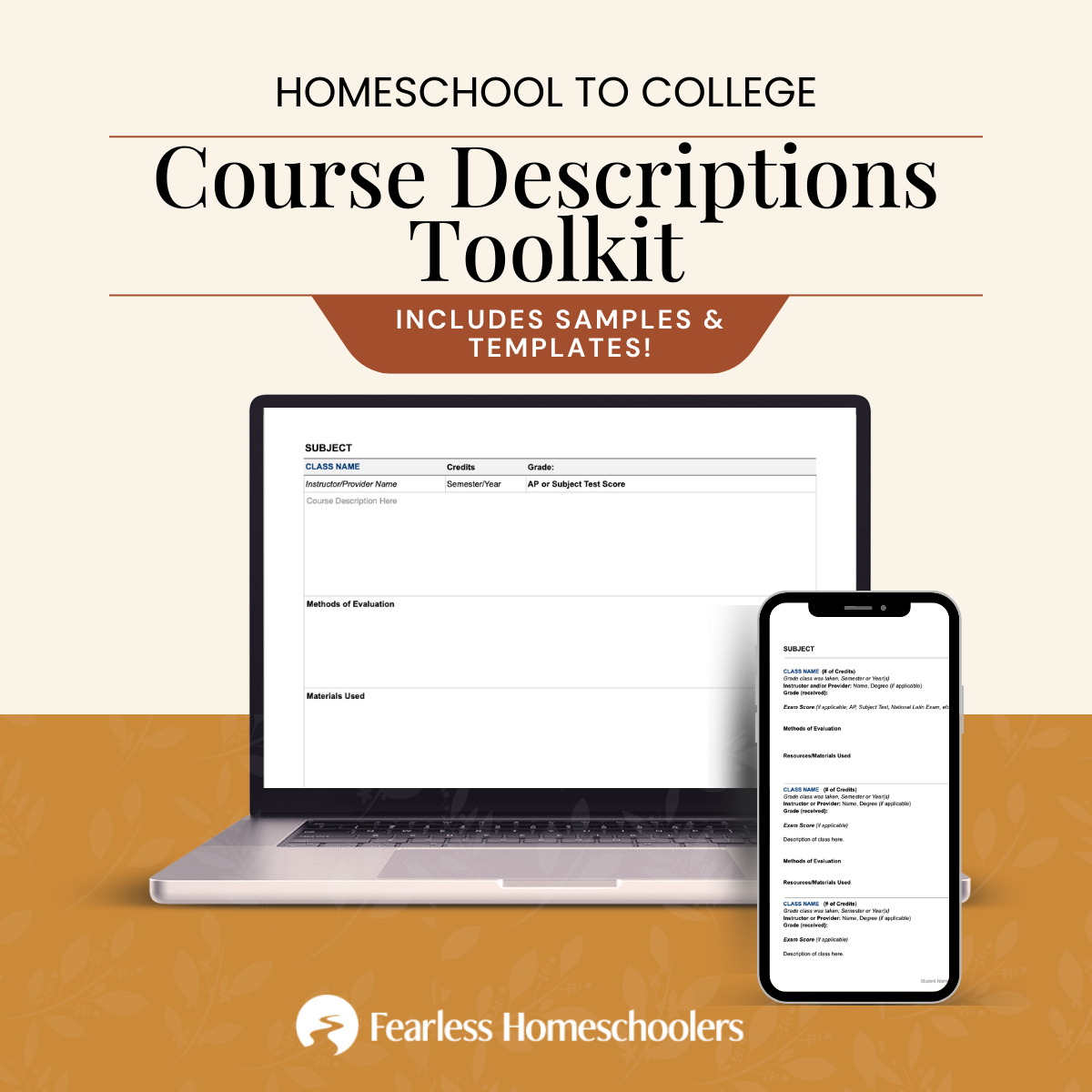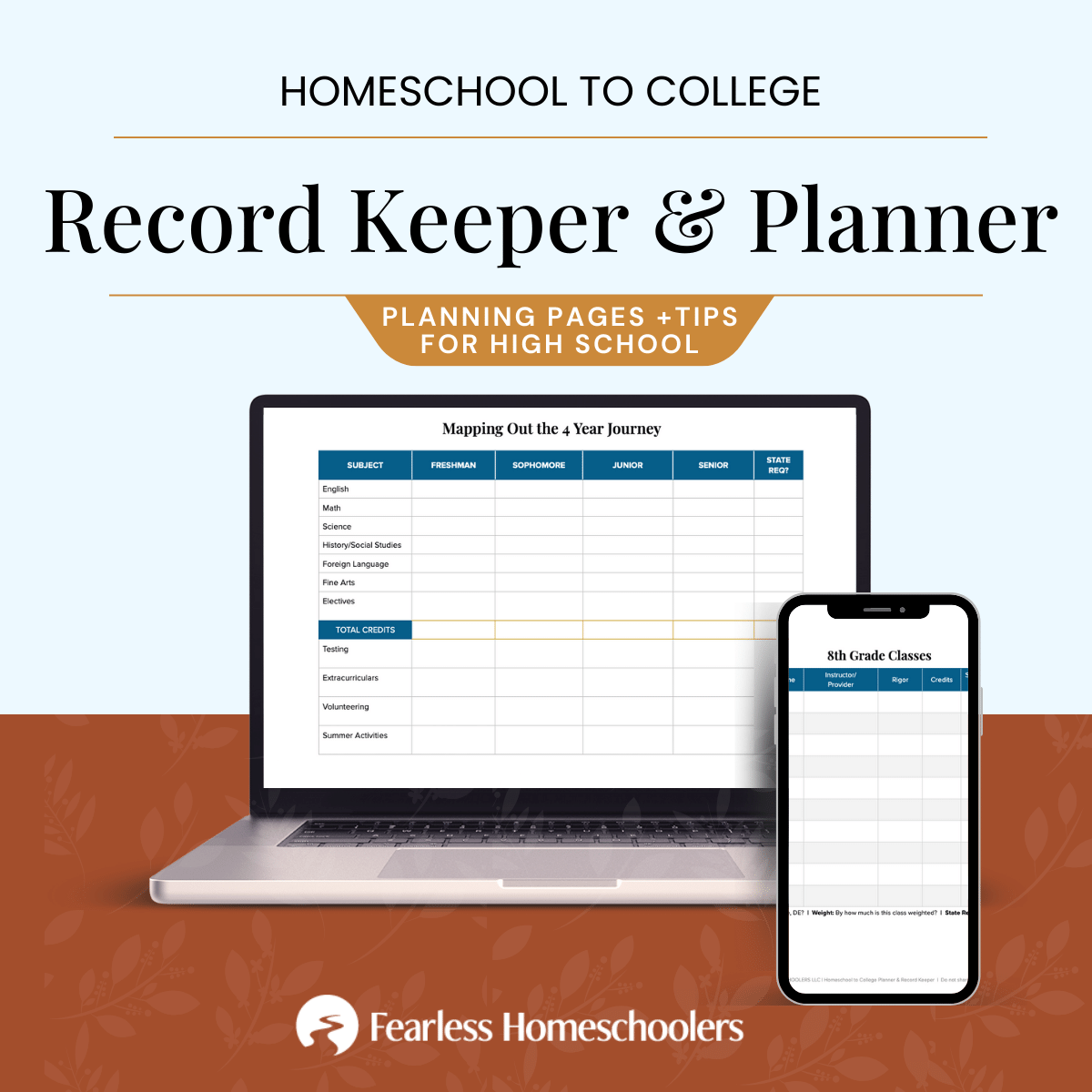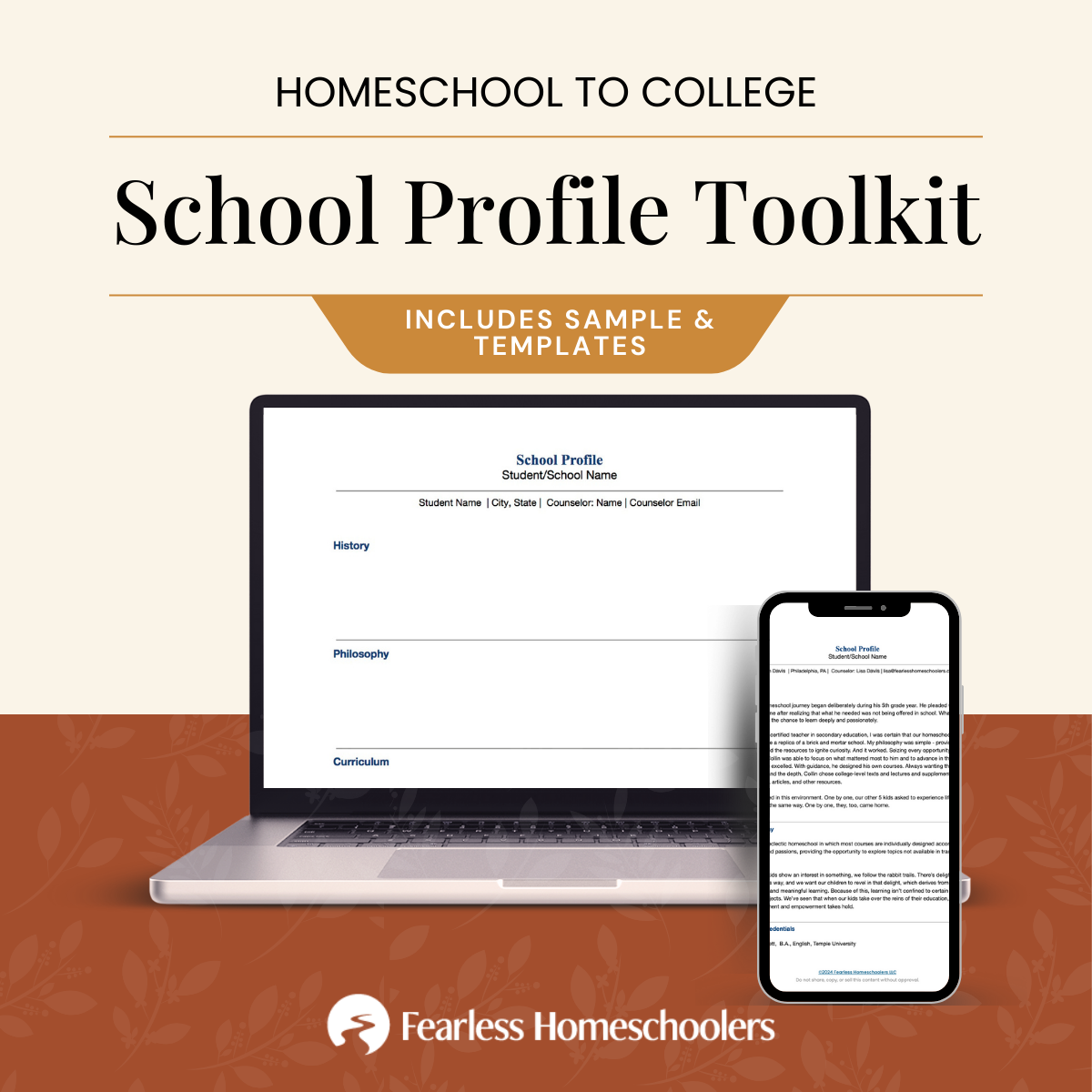How to Create a Homeschool Transcript that Colleges Love (Template + Guide)
There I was - another night of lying wide awake in the dark.
My husband - snoring peacefully next to me - didn’t know I was worried.
Like, really worried.
- What if I made a horrible mistake by homeschooling in the first place?
- What if my homeschool isn’t taken seriously by the colleges on my son’s list?
- What the heck do schools want from homeschoolers anyway?
I was at the beginning of the college admissions journey with my first kid.
And the homeschool transcript worried me most.
One page. That’s all it is! And it was enough to keep me up at night.
How can a one page homeschool transcript template sprinkled with letters and numbers cause us so much aggravation?
Because this simple document tells our homeschooler’s story. And this simple document is supposed to move admissions officers to say yes to that story.
What I’ve learned over the years
After launching 5 of my own kids into college and helping hundreds of other homeschoolers, I’ve learned that there’s no one way to create a transcript. There are lots of great ways.
Just find the way that best reflects your homeschool and your homeschooler’s story.
Find the way that allows you to sleep peacefully at night.

The homeschool high school transcript is a great way to tell your story in the college application.
What is the homeschool transcript?
Very simply, the transcript is a one-page document that provides a quick overview of a student’s high school courses, grades, GPA, and, if desired, test scores (more on that later).
Not only does a transcript serve as a key college admissions piece, but it can also be used for scholarships, contests, internships, certifications, and jobs. Note that the transcript differs from another document called Course Descriptions.
Do colleges really accept transcripts from homeschoolers?
Absolutely! A homeschooler’s transcript is just as valid as any other school’s transcript. Colleges accept homeschool transcripts and students all the time. Pinky swear.
What makes a homeschool high school transcript official?
To make your transcript template official, all you have to do is sign it, date it, and write the word “Official” at the top. That’s it.
Do I need to get my homeschool transcript notarized?
Nope. You, the homeschool parent, make the transcript official. No one else needs to do it for you.
Does my homeschool transcript need to be accredited?
No accreditation is necessary. As homeschool parent, you are the director of your homeschool. Your signature is enough. There’s no need to spend time and money obtaining an “accredited” transcript or using an accredited high school.
What does a homeschool transcript look like? Can I see an example?
A homeschool high school transcript looks similar to any other transcript. Colleges prefer that it be one page and easy to read. Take a peek at the homeschool transcript template example below. Professional and easy to read, right?
👉 Grab this Homeschool Transcript Template HERE!
How to Create the Homeschool Transcript: Step by Step
Making your transcript is easy! You don’t need an homeschool transcript service or expensive record-keeping software to do it for you.
- Start early and keep thorough records each year of high school. The easiest way to do this is to grab the Homeschool to College Planner. Great homeschool records = great college applications!
- Name each course. If a course is taken at home, feel free to give it a unique name. Just be sure it’s clear what subject it is.
- Decide if and how you will weight your GPA to reflect rigor. Some schools immediately unweight and recalculate GPA’s according to their own system, but some use weighted grades for merit scholarships. You don’t want to miss out on those!
- Establish a grading scale and give each class a grade. Will you use pluses and minuses? Percentages?
- Assign credits to each class. There are a few ways to do this, but most assign 1.0 credit for 120-160 hours of work.
- Calculate the yearly GPA and the cumulative GPA. Use the FREE Fearless Homeschoolers GPA Calculator!
- Decide if you want standardized test scores on the transcript. Don’t include them if you’re applying test-optional.
- Determine if a subject or year transcript best showcases your homeschooler’s strengths.(Hint: colleges prefer transcripts organized by year. See below.)
- Create your transcript in Google Docs using my transcript template.
- Make it official. Label it “Official High School Transcript”, sign it, and date it!
- Upload the transcript in the “School Report” section of your Counselor Account in the Common App or in the institution’s online application.
- Be sure to send an updated transcript in your midyear and final reports.
What homeschool transcript template is best?
Your transcript has a job - to tell your homeschooler’s academic story in one easy-to-read, easy-to-understand page. Here are some important questions to ask when looking for the best transcript template.
- Does it tell my homeschooler’s story accurately?
- Does it offer the grading scale I use?
- Does it offer the weighting system I use?
- Does it show weighted and unweighted GPA?
- Does it show semester, yearly, and cumulative GPA?
- Can I designate classes as Honors or AP or Dual Enrollment?
- Can I add outside provider names if I want?
- Is it one page?
- Is it cluttered?
- Is there a place for test scores?
- Is there a place to add middle school courses or pass/fail courses?
- Is there a place to add notes?
- Does it allow me to easily show senior classes in progress?
- Does it allow me to easily show senior classes planned for spring?
- Does it allow me to easily update as a midyear report? Final Transcript?
If you’re looking for one that considers all of the above, grab my Transcript Template now!
FAQs for Homeschool High School Transcripts
What should I name the courses?
Should your course names be creative? Or should they be standard?
Your homeschooler’s education was not standard, so if you have the chance to label their English Class, The Power of Voice in Women’s Literature, do it. Sounds better than 11th grade English, eh? Just make sure it isn’t difficult to decipher what subject the class is!
Should I weight my homeschool GPA?
To weight or not to weight? That is the question.
Because Honors and AP courses are more demanding, some schools give more weight to them. Instead of a class being 1.0 quality point, they assign it 1.5 or 2.0 quality points - weighting those classes by .5 or 1.0 respectively.
Whether you weight or not is really a personal choice, as is so much of this process.
What You May Not Know
Many schools unweight grades before reviewing the homeschool high school transcript.
Why? Because there is no standard in the way schools weight courses. Some base it on a 4.0 scale, others on a 5.0 or 6.0 scale.
In order to streamline the process, admissions officers recalculate on an unweighted 4.0 scale (many times excluding electives). They then assess those courses according to their school’s particular rubric used when evaluating an applicant.
It seems that unweighted grades are the way to go, right? However…
Another little secret
Some schools use a weighted GPA for scholarship purposes.
If your student is going to compete with others from schools that weight rigorous courses, you should consider doing the same.
What’s the best way to know if the schools on your homeschooler’s list use a weighted GPA for merit scholarships?
Some institutions will share this information; some will not. It’s best to call the admissions office and ask!
Can I have honors or AP classes on the homeschool transcript?
If an outsourced course is labeled Honors or AP, certainly call it that on your transcript. If you think the course is much more demanding than a typical high school course, feel free to call it Honors.
How much it matters depends on the specific admissions officer and if those grades are backed up by thorough course descriptions and/or Subject Tests or AP scores.
IMPORTANT: AP courses must be officially approved by College Board. If your course has not been officially approved, you may not list it as such on the transcript.
What kind of grading scale should I use?
Each transcript should have a grading key or grading scale. This explains your grading system in an efficient way to the admissions officer. There are a variety of scales from which to choose. Pick one and be consistent.
Here are two of the most commonly used grading scales.
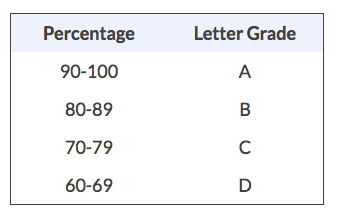

How do I calculate my homeschooler’s GPA?
The easiest way is to use the Fearless Homeschoolers free online GPA calculator.
If you’re interested in doing it the old school way, here’s the blow by blow:
There are two GPA calculations on the transcript. First, there is GPA by year. Second, there is cumulative GPA.
Step 1. Assign each course a numerical grade. Let’s make this easy and base it on a 4.0 scale.
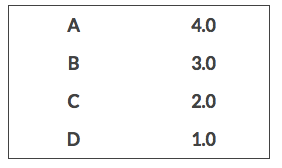
Step 2. Multiply that numerical grade by credit amount.
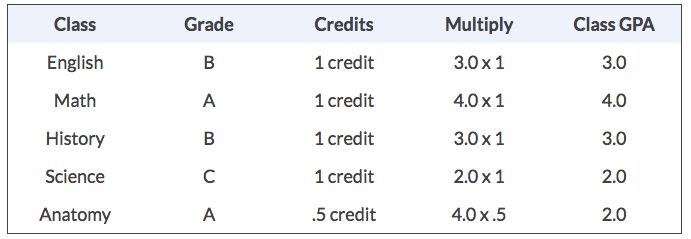
Step 3. Add up all grade points and divide by number of credits.
3+4+3+2+2= 14
14/4.5= 3.11 GPA
Cumulative GPA:
To get a cumulative GPA, add up each year’s grade points and divide by the number of credits taken over those years.
> Note: the cumulative GPA is NOT an average of each year because the number of classes taken each year is different.
👉 Get Your Homeschool Transcript Template HERE!
Should I include test scores on my homeschool transcript?
SAT scores, ACT scores, Subject Test scores, and AP scores can be included UNLESS applying test-optional (choosing to not send scores to a test-optional school.)
For obvious reasons, you wouldn’t want those scores on the transcript.
Insider Tip: Many students think they are required to put scores in the Common Application when asked! They are not and should not, if applying test optional.
Should I organize my homeschool transcript by subject or year?
There are two main kinds of transcripts that homeschoolers use; they differ in their organization.
- Subject: Organized by subject and is usually front-loaded by student’s strongest subjects.
- Date: Organized by year. Similar to brick and mortar school transcripts.
Which transcript to use depends on your homeschooler. Does one type seem to reflect their story better than another?
Does one highlight their strengths better than another? If you have a student who has studied a few languages or a student who has doubled or tripled up in math, a subject transcript may work best for you.
On the other hand, if your teen isn’t strong in a particular subject, a subject transcript will make that painfully obvious!
How do I send colleges my homeschool transcript?
Each college uses an online application platform. There, you’ll find instructions for submitting and uploading your transcript. If it doesn’t seem clear for you as a homeschooler, reach out to admissions and ask.
Where should I upload the transcript on the Common App?
In the your “Students” Section of the Counselor’s Common App account, click on your homeschooler’s name, click on “School Report” and then “Transcripts”.
Here it will ask you how many transcripts you want to upload. Read as “How many pdfs do you want to upload?”
If you’re including Course Descriptions, you would select 2.
Upload the transcript in the first slot. (Course descriptions would go under “Additional Transcript” slot.)
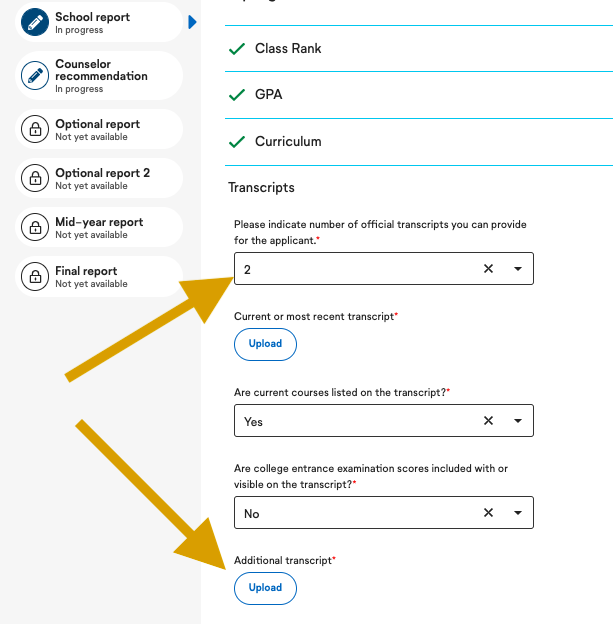
Note: If you select “1” transcript, you’ll be able to choose up to 3 files from your computer files. If you choose your transcript PDF & your course descriptions PDF, they will be combined into one long PDF. This is a fine option. But if you’d like to keep them separate, select “2” transcripts & upload in 2 different slots.
Do I need to submit transcripts and official grade reports from outsourced classes?
There’s no need to send every transcript or grade report. Here are the basic guidelines for what gets sent and what doesn’t.
College or University Courses Taken During High School
Ask the school to send your homeschooler’s transcript directly to colleges.
Online Courses
Sometimes online providers offer an official grade report. Your homeschooler takes English from one provider and math from another? Unless your student has taken the bulk of their classes from that provider, just transfer the grade onto your homeschool transcript.
What if My Teen Attended a Brick and Mortar School or an Online School Before Homeschooling?
If your homeschooler’s high school years included a school that was not legally a homeschool, you have two choices.
- Your transcript only includes the homeschool years.
- Your transcript includes all four years.
When this gets tricky: If you cannot easily translate the former high school grades into your homeschool grading system and GPA calculation, leave those years out. College admissions officers prefer that we not translate the other school’s grades ourselves. Leave that to them. They see students from a variety of schools, grading systems, and transcripts. They would prefer to do the interpreting themselves.
Former Homeschoolers Who Currently Attend a High School
Email a homeschool transcript (with course descriptions and counselor recommendation letter) directly to each college the student is applying to. This clears up any questions admissions officers have regarding the specifics of their homeschool education.
Should I include middle school courses on the homeschool transcript?
In general, middle school courses should not be listed. The high school transcript is a transcript for high school courses.
However, look at each school’s requirements. Do they require 4 years of each subject? Do you need that 8th grade Algebra course on the transcript to meet those requirements? If so, then include it. If not, then it’s not necessary.
The two middle school subjects - if taken at a high school level - acceptable to put on a high school transcript are Math and Foreign Language. A high school biology class taken during middle school is also commonly seen.
Do I include planned Fall Semester Classes that are in progess?
Yes! Include all planned 12th grade courses on your transcript. For fall classes, include the names of the courses and note that that they are In Progress or “IP”.
TIP: If fall semester grades are particularly strong and they weren’t sent with the original transcript, send them to the school via email or the “Optional Report” on the Common App. If a student is considered a borderline applicant, a strong start to senior year could have an impact!
What about Spring Semester 12th Grade Classes?
As with the fall classes, list any spring classes as “SP”. The grades for those classes will be sent with the counselor’s final report.
(Yes, you’ll be sending a final report with an updated and “FINAL” transcript. Be sure to include the graduation date on that final transcript.)
Independent projects
Look at the application in its entirety. When put together, the application should reveal all that your homeschooler is.
There are two places independent projects and studies can go - on the activities list or on the transcript. First, ask yourself if the independent study involved enough hours. If so, the transcript is an option. Then ask yourself if it is worthy of a course description, rather than the 150 characters available in the activities section of the Common App. If so, the transcript is the way to go.
Electives on the Transcript
If the electives are interesting and important to the student’s story, include those electives. Physical education or health? There’s no need to include them unless you’d like to.
Note: For most of you, the transcript you send to colleges does not need to include all of your state’s requirements. For CA and NY residents applying to in-state schools, it may be a different story.
What Does NOT Go on a Transcript?
Activities, awards, and course descriptions do not belong on the transcript, especially if using the Common App. There are specific sections to list those items. If not using the Common App, and there’s no section to include such accomplishments, consider creating a separate document.
The Homeschool Transcript Checklist
Use this checklist as you create and review your transcript.
- “Official High School Transcript” or “Official Homeschool Transcript”
- Date of Graduation
- Name of Student
- Address
- Date of Birth
- Counselor Name
- Counselor Email
- Credits Per Year
- Total High School Credits
- GPA Per Year
- Cumulative GPA
- Grading Key
- Standardized Test Scores (if you choose)
- Parent Signature and Date
As you can see, much of what you choose to include is up to you. And the right homeschool transcript template makes all the difference in telling the story you want to tell.
Want More on Homeschool Transcripts?
- The Ultimate Guide to Homeschool Credits for High School
- 3 Things Colleges Want to See on Your Homeschool Transcript
- How to Create Course Descriptions as a Homeschooler
- How to Navigate the Common App as a Homeschool Parent
- Why Your Homeschool Transcript Should Be Organized by Year
- Homeschooler’s Ultimate Guide to SAT and ACT Testing
Your Turn
What trips you up most about the homeschool transcript? Share in a comment below!
